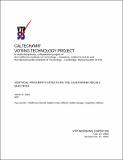| dc.contributor.author | Sled, Sarah M. | |
| dc.date.accessioned | 2015-04-14T16:48:02Z | |
| dc.date.available | 2015-04-14T16:48:02Z | |
| dc.date.issued | 2003-10-27 | |
| dc.identifier.uri | http://hdl.handle.net/1721.1/96545 | |
| dc.description.abstract | The 2003 California recall election provides a unique opportunity to assess the impact of variations in ballot design and voting methods on the voting accuracy of citizens. Analysis of the results of the California Recall election demonstrates that candidates who were vertically adjacent to the top three vote getters received “extra” votes in the recall election – a vertical proximity effect. Combined, these ‘neighbor’ candidates received approximately 4 votes per thousand votes the top candidate received. The pattern is consistent across the candidates neighboring Schwarzenegger, Bustamante, and McClintock, and is noticeably higher for punch cards than for optical scan or touch
screen voting technologies. | en_US |
| dc.language.iso | en_US | en_US |
| dc.publisher | Caltech/MIT Voting Technology Project | en_US |
| dc.relation.ispartofseries | VTP Working Paper Series;8 | |
| dc.subject | California recall | en_US |
| dc.subject | Ballot order effects | en_US |
| dc.subject | Ballot design | en_US |
| dc.subject | Neighbor effects | en_US |
| dc.title | Vertical Proximity Effects in the California Recall Election | en_US |
| dc.type | Working Paper | en_US |
